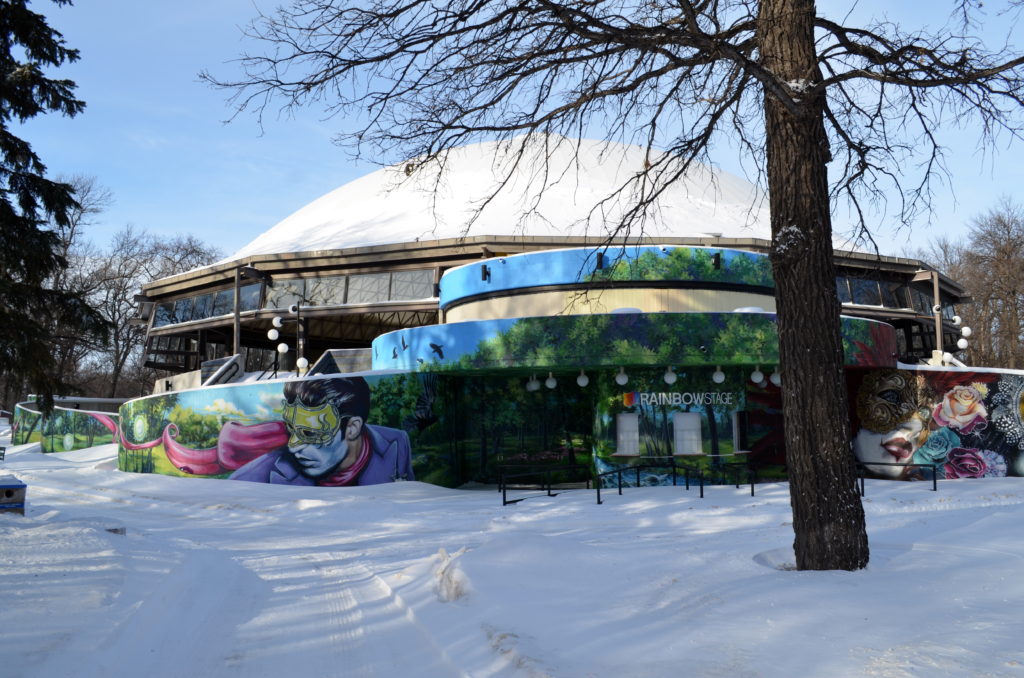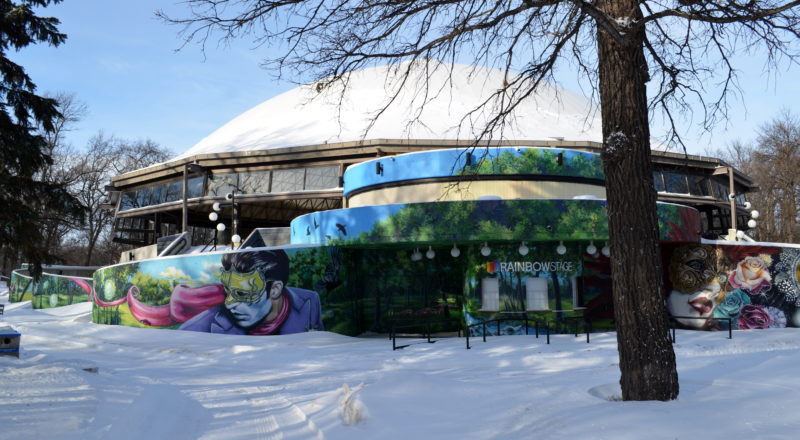
/ Blog
April 28, 2021
A Theatre Under the Stars: Rainbow Stage
If you find yourself in Kildonan Park on a summer night, you might hear the sounds of music and applause carried across the air. The noise is, of course, coming from Rainbow Stage (2021 Main Street).
Built in 1954, Rainbow Stage is Canada’s largest and longest running outdoor theatre and it is situated, fittingly, in one of Winnipeg’s oldest and largest parks. Kildonan Park itself was established in 1909 and initially consisted of 78-acres of lush greenspace and picnic areas. The popularity of urban parks in the 1910s led to a variety of public events being held both in Kildonan Park and Assiniboine Park, and to the creation of a permanent bandstand in Kildonan Park in 1917.
For years, this bandstand hosted live music, dance contests, and large-scale community sing-a-longs hosted by the Winnipeg Tribune newspaper. These “Nights of Community Song”, held across the 1920s and 30s, saw significant turn out. The 1933 event saw a crowd of 20,000!
The bandstand stood in Kildonan Park until the 1950 flood. The spring of that year saw exceptionally high flood-waters, spilling over the banks of the Red River and into many of Winnipeg’s riverside communities. Approximately 10,000 homes were destroyed and 5,000 buildings were damaged, among them the Kildonan Park Bandstand. Following the flood there was a general agreement that the bandstand needed to be replaced, but the question remained: with what? Bandstands were no longer the popular attraction they were at the start of the 20th century, and music tastes had shifted radically. A military band playing old standards was no longer going to draw a crowd of thousands.
Some looked west for inspiration. In Vancouver, in Stanley Park, the Theatre Under the Stars had become a popular summer attraction following its construction in 1940. The Winnipeg Junior Chamber of Commerce and the Civic Music League used this theatre as an example of what they would like to see in Kildonan Park. It was a solid pitch; a soundstage could provide a place for local musical and theatrical talents, and provide a new tourist attraction in the city.
The City of Winnipeg offered $15,000 towards the construction of the new stage, while another $15,000 was raised through public fundraising efforts. Led by the Civic Music League, the fundraising campaign involved radio contests, a limerick competition, and canvassing at local businesses. Work began on the theatre in 1951, and was mostly completed in the spring of 1953. The new theatre was named Rainbow Stage, due to the long band of rainbow lights running along the wooden arch above the stage. Architects Smith, Carter, Katelnikoff designed the 3,000 seat theatre.
The first concert at Rainbow Stage took place on September 22nd, 1953, with the Kitsilano Boys Band performing. The Kitsilano Boys Band was founded in 1928 in Vancouver, and by the 1950s were a well-regarded and well-established musical group with roughly forty members. Their visit to Winnipeg in 1953 came shortly after a tour of the United Kingdom and Ireland. There was one slight hiccup to the performance, when a breeze abruptly blew the band’s music off the stage, but otherwise the concert was warmly received. The concert was not the official opening of Rainbow Stage, as there was still some construction to work to be done, but it signaled that the end of the project was near. Between 1953-4, two pergolas were added on opposite sides of the seating area, as were two dressing rooms that fit 25 people each.
The official opening of Rainbow Stage took place on July 7th 1954. Bill Walker, the night’s M.C., called the event a “family affair.” The Ukrainian Youth Association performed first, as peanut and popcorn vendors wove their way through the crowd. The James Duncan chorus took the stage next, performing songs from the musical Carousel; other performers included Bill Walker and Len Adree, Eric Wild and his CBC Orchestra, and the Jewish Community Choir with Cantor Benjamin Brownstown. According to a young boy in the crowd, the “music had a fizz in it.”
A variety of local groups performed at Rainbow Stage across 1954/55, from movie screenings to square dancing competitions. It took until September of 1955 for musical theatre to reach Rainbow Stage, when James Duncan directed a production of Brigadoon. In the years since, musical theatre has remained a staple of Rainbow Stage’s summer seasons. In the decade that followed, Rainbow Stage would produce a number of beloved musicals including Kiss Me Kate, The Wizard of Oz, The King and I, and Guys and Dolls. Of course, these were the years where Rainbow Stage lacked any sort of roof, so all performances were at risk of being cancelled due to poor weather.
John Douglas, the president of Rainbow Stage Productions, began pressing the City of Winnipeg for a dome to cover the stage in 1965. In 1969, after a committee had been formed to raise the costs of a new roof, Rainbow Stage awarded the Dominion Bridge Company the contract. Architect Jack Ross was hired to create the roof, which uses 63 tons of steel to form a hemispherical triodetic roof. Once completed, the dome was covered with a fabric tarp. After several years, the fabric cover was replaced with a more rain-proof plastic one.
Additional upgrades were performed across the 1970s, with the introduction of new washrooms, ticket booths, and other amenities. Ross designed these upgrades as well and this time using brutalist tradition for inspiration. Meandering exposed concrete walls curve around the auditorium space, with outcroppings of seating areas scattered throughout. During these renovations, 600 seats were removed and the seating capacity dropped to a still-impressive 2,400.
Backstage upgrades were added in 1986, with the introduction of a fly gallery, carpentry and paint shops, classrooms and expanded change rooms. The original timber arch which once gave Rainbow Stage its name was replaced during these renovations, and a plaque commemorating the original arch sits in Kildonan Park.
True to the Winnipeg Junior Chamber of Commerce and the Civic Music League’s predictions, Rainbow Stage established itself as a tourist attraction in Winnipeg. That made its way into a variety of promotional pamphlets for Winnipeg, including the promotional materials for the 1967 Pan-Am games.
Over the years, programming at Rainbow Stage has varied in size. There were an astonishing seven shows in 1957, though the usual standard is one to three musical productions in a year. More recently, it has become easier for regional theatres to obtain the rights to newer musicals, and since 2010 Rainbow Stage has organized both smaller adult-oriented musicals, like Rent, and larger family-friendly productions, such as Cinderella in 2019. Additional educational programs have been introduced as well, from dance classes, workshops, and student scholarships and awards.
Throughout it all, local talent has remained a mainstay of all Rainbow Stage productions. The likes of John Hirsch, Evelyne Anderson, and Eric Wild have all had a hand in Rainbow Stage productions over the years. It is presently closed due to COVID-19 but Rainbow Stage still remains a remarkable theatrical jewel here in Winnipeg.

Rainbow Stage in 2013.
Source: Ccyyrree, CC0, via Wikimedia Commons
THANK YOU TO THE SPONSOR OF THIS BLOG POST:

Sabrina Janke on behalf of Heritage Winnipeg.
SOURCES:
The Unique Architecture of Kildonan Park, Winnipeg Real Estate News
Rainbow Stage, the Canadian Encyclopedia
Rainbow Stage, Winnipeg Architecture Foundation
Jack Ross, Winnipeg Architecture Foundation
Kildonan Park: Strolling Through History
Theatre Under the Stars (Vancouver)
Rainbow Stage: More Than Just Musical Theatre, Community News Commons
Winnipeg Tribune Files
Winnipeg Free Press Files











